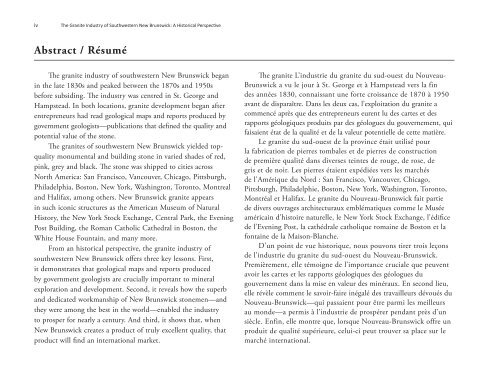The Granite Industry of Southwestern New Brunswick: A Historical ...
The Granite Industry of Southwestern New Brunswick: A Historical ...
The Granite Industry of Southwestern New Brunswick: A Historical ...
You also want an ePaper? Increase the reach of your titles
YUMPU automatically turns print PDFs into web optimized ePapers that Google loves.
iv<br />
<strong>The</strong> <strong>Granite</strong> <strong>Industry</strong> <strong>of</strong> <strong>Southwestern</strong> <strong>New</strong> <strong>Brunswick</strong>: A <strong>Historical</strong> Perspective<br />
Abstract / Résumé<br />
<strong>The</strong> granite industry <strong>of</strong> southwestern <strong>New</strong> <strong>Brunswick</strong> began<br />
in the late 1830s and peaked between the 1870s and 1950s<br />
before subsiding. <strong>The</strong> industry was centred in St. George and<br />
Hampstead. In both locations, granite development began after<br />
entrepreneurs had read geological maps and reports produced by<br />
government geologists—publications that defined the quality and<br />
potential value <strong>of</strong> the stone.<br />
<strong>The</strong> granites <strong>of</strong> southwestern <strong>New</strong> <strong>Brunswick</strong> yielded topquality<br />
monumental and building stone in varied shades <strong>of</strong> red,<br />
pink, grey and black. <strong>The</strong> stone was shipped to cities across<br />
North America: San Francisco, Vancouver, Chicago, Pittsburgh,<br />
Philadelphia, Boston, <strong>New</strong> York, Washington, Toronto, Montreal<br />
and Halifax, among others. <strong>New</strong> <strong>Brunswick</strong> granite appears<br />
in such iconic structures as the American Museum <strong>of</strong> Natural<br />
History, the <strong>New</strong> York Stock Exchange, Central Park, the Evening<br />
Post Building, the Roman Catholic Cathedral in Boston, the<br />
White House Fountain, and many more.<br />
From an historical perspective, the granite industry <strong>of</strong><br />
southwestern <strong>New</strong> <strong>Brunswick</strong> <strong>of</strong>fers three key lessons. First,<br />
it demonstrates that geological maps and reports produced<br />
by government geologists are crucially important to mineral<br />
exploration and development. Second, it reveals how the superb<br />
and dedicated workmanship <strong>of</strong> <strong>New</strong> <strong>Brunswick</strong> stonemen—and<br />
they were among the best in the world—enabled the industry<br />
to prosper for nearly a century. And third, it shows that, when<br />
<strong>New</strong> <strong>Brunswick</strong> creates a product <strong>of</strong> truly excellent quality, that<br />
product will find an international market.<br />
<strong>The</strong> granite L’industrie du granite du sud-ouest du Nouveau-<br />
<strong>Brunswick</strong> a vu le jour à St. George et à Hampstead vers la fin<br />
des années 1830, connaissant une forte croissance de 1870 à 1950<br />
avant de disparaître. Dans les deux cas, l’exploitation du granite a<br />
commencé après que des entrepreneurs eurent lu des cartes et des<br />
rapports géologiques produits par des géologues du gouvernement, qui<br />
faisaient état de la qualité et de la valeur potentielle de cette matière.<br />
Le granite du sud-ouest de la province était utilisé pour<br />
la fabrication de pierres tombales et de pierres de construction<br />
de première qualité dans diverses teintes de rouge, de rose, de<br />
gris et de noir. Les pierres étaient expédiées vers les marchés<br />
de l'Amérique du Nord : San Francisco, Vancouver, Chicago,<br />
Pittsburgh, Philadelphie, Boston, <strong>New</strong> York, Washington, Toronto,<br />
Montréal et Halifax. Le granite du Nouveau-<strong>Brunswick</strong> fait partie<br />
de divers ouvrages architecturaux emblématiques comme le Musée<br />
américain d’histoire naturelle, le <strong>New</strong> York Stock Exchange, l’édifice<br />
de l’Evening Post, la cathédrale catholique romaine de Boston et la<br />
fontaine de la Maison-Blanche.<br />
D’un point de vue historique, nous pouvons tirer trois leçons<br />
de l’industrie du granite du sud-ouest du Nouveau-<strong>Brunswick</strong>.<br />
Premièrement, elle témoigne de l’importance cruciale que peuvent<br />
avoir les cartes et les rapports géologiques des géologues du<br />
gouvernement dans la mise en valeur des minéraux. En second lieu,<br />
elle révèle comment le savoir-faire inégalé des travailleurs dévoués du<br />
Nouveau-<strong>Brunswick</strong>—qui passaient pour être parmi les meilleurs<br />
au monde—a permis à l’industrie de prospérer pendant près d’un<br />
siècle. Enfin, elle montre que, lorsque Nouveau-<strong>Brunswick</strong> <strong>of</strong>fre un<br />
produit de qualité supérieure, celui-ci peut trouver sa place sur le<br />
marché international.
















